The Temperature Relationship of Batrachochytrium dendrobatidis: Difference between revisions
No edit summary |
|||
| Line 6: | Line 6: | ||
<br>Amphibian species around the world are experiencing unprecedented population decline due to the emerging infectious disease chytridiomycosis, which is caused by the chytrid fungus <i>Batrachochytrium dendrobatidis</i> (Bd).<ref name=Weldon2004>[https://www.ncbi.nlm.nih.gov/pmc/articles/PMC3323396/ Weldon et al. 2004. Origin of the Amphibian Chytrid Fungus. Emerging Infectious Diseases. 10(12):2100-2105]</ref> The chytrid pathogen is considered an emerging infectious disease because it was discovered and described only in the last twenty years, and has continued to spread globally causing devastating effects.<ref name=Piotrowski2004>[https://www.ncbi.nlm.nih.gov/pubmed/21148822/ Piotrowski et al. 2004. Physiology of Batrachochytrium dendrobatidis, a Chytrid Pathogen of Amphibians. Mycologia. 96:9-15]</ref> <i>Batrachochytrium dendrobatidis</i> has been documented in hundreds of amphibian species, and reports of infection in new species and geographic locations continue to accumulate rapidly.<ref name=Rosenblum2010>[https://www.ncbi.nlm.nih.gov/pmc/articles/PMC2813266/ Rosenblum et al. 2010. The Deadly Chytrid Fungus: A Story of an Emerging Pathogen. PLoS Pathogens. 6(1):e1000550]</ref><br> | <br>Amphibian species around the world are experiencing unprecedented population decline due to the emerging infectious disease chytridiomycosis, which is caused by the chytrid fungus <i>Batrachochytrium dendrobatidis</i> (Bd).<ref name=Weldon2004>[https://www.ncbi.nlm.nih.gov/pmc/articles/PMC3323396/ Weldon et al. 2004. Origin of the Amphibian Chytrid Fungus. Emerging Infectious Diseases. 10(12):2100-2105]</ref> The chytrid pathogen is considered an emerging infectious disease because it was discovered and described only in the last twenty years, and has continued to spread globally causing devastating effects.<ref name=Piotrowski2004>[https://www.ncbi.nlm.nih.gov/pubmed/21148822/ Piotrowski et al. 2004. Physiology of Batrachochytrium dendrobatidis, a Chytrid Pathogen of Amphibians. Mycologia. 96:9-15]</ref> <i>Batrachochytrium dendrobatidis</i> has been documented in hundreds of amphibian species, and reports of infection in new species and geographic locations continue to accumulate rapidly.<ref name=Rosenblum2010>[https://www.ncbi.nlm.nih.gov/pmc/articles/PMC2813266/ Rosenblum et al. 2010. The Deadly Chytrid Fungus: A Story of an Emerging Pathogen. PLoS Pathogens. 6(1):e1000550]</ref><br> | ||
==Phylogeny== | ==Phylogeny== | ||
| Line 28: | Line 23: | ||
<br><b>Genus:</b> <i>Batrachochytrium</i> | <br><b>Genus:</b> <i>Batrachochytrium</i> | ||
<br><b>Species:</b> <i>B. dendrobatidis</i> | <br><b>Species:</b> <i>B. dendrobatidis</i> | ||
==Effect on Amphibians== | |||
===Effect of Temperature=== | |||
==Life Cycle== | ==Life Cycle== | ||
Revision as of 22:49, 29 April 2020
Introduction
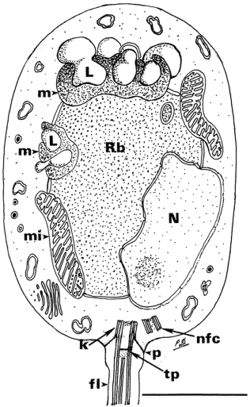
By [Eva Brazer]
Amphibian species around the world are experiencing unprecedented population decline due to the emerging infectious disease chytridiomycosis, which is caused by the chytrid fungus Batrachochytrium dendrobatidis (Bd).[2] The chytrid pathogen is considered an emerging infectious disease because it was discovered and described only in the last twenty years, and has continued to spread globally causing devastating effects.[3] Batrachochytrium dendrobatidis has been documented in hundreds of amphibian species, and reports of infection in new species and geographic locations continue to accumulate rapidly.[4]
Phylogeny
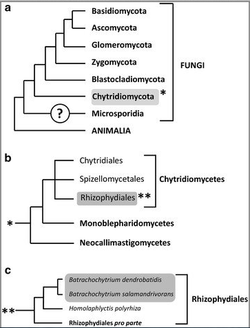
Scientific classification
Kingdom: Fungi
Division: Chytridiomycota
Class: Chytridiomycetes
Order: Rhizophydiales
Genus: Batrachochytrium
Species: B. dendrobatidis
Effect on Amphibians
Effect of Temperature
Life Cycle
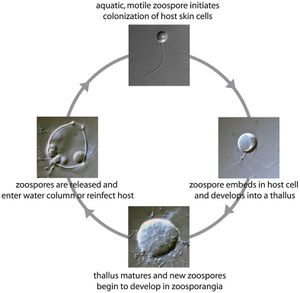
Effect of Temperature
Geographic Distribution
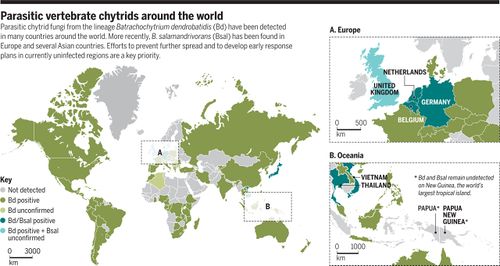
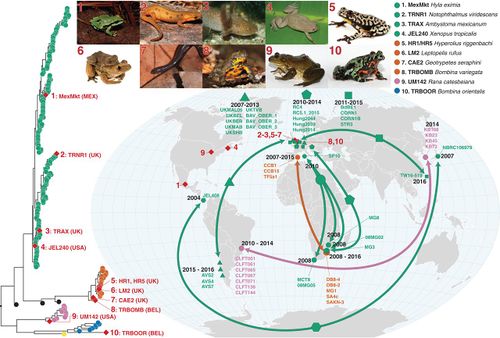
Effect of Temperature
Climate Change
Conclusion
References
- ↑ Berger et al. 2005. Life cycle stages of the amphibian chytrid Batrachochytrium dendrobatidis. Inter-Research. 68:52-63
- ↑ Weldon et al. 2004. Origin of the Amphibian Chytrid Fungus. Emerging Infectious Diseases. 10(12):2100-2105
- ↑ Piotrowski et al. 2004. Physiology of Batrachochytrium dendrobatidis, a Chytrid Pathogen of Amphibians. Mycologia. 96:9-15
- ↑ 4.0 4.1 Rosenblum et al. 2010. The Deadly Chytrid Fungus: A Story of an Emerging Pathogen. PLoS Pathogens. 6(1):e1000550
- ↑ Rooij et al. 2015. Amphibian chytridiomycosis: A review with focus on fungus-host interactions. Veterinary Research. 46(1):137.
- ↑ Bower et al. 2017. Amphibians on the brink: Preemptive policies can protect amphibians from devastating fungal diseases. Science. 357:454-455
- ↑ O’Hanlon et al. 2018. Recent Asian origin of chytrid fungi causing global amphibian declines. Science. 360:621-627
Authored for BIOL 238 Microbiology, taught by Joan Slonczewski, 2018, Kenyon College.
